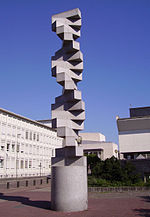Friedrich-Ebert-Halle
Buildings and structures in Rhineland-PalatinateIndoor arenas in GermanySport in LudwigshafenSports venues in Rhineland-Palatinate

Friedrich-Ebert-Halle (also known as Eberthalle) is an indoor arena located in Ludwigshafen, Germany, which can accommodate 2,250 guests. The facility was designed by Roland Rainer and completed in 1965. It is used for sporting events, fairs, exhibitions and concerts. Past performers include The Kinks, The Who, Dio, Rainbow and Whitesnake.
Excerpt from the Wikipedia article Friedrich-Ebert-Halle (License: CC BY-SA 3.0, Authors, Images).Friedrich-Ebert-Halle
Erzbergerstraße, Ludwigshafen am Rhein Ludwigshafen-Friesenheim
Geographical coordinates (GPS) Address External links Nearby Places Show on map
Geographical coordinates (GPS)
| Latitude | Longitude |
|---|---|
| N 49.4914 ° | E 8.4129 ° |
Address
Friedrich-Ebert-Halle
Erzbergerstraße 89
67063 Ludwigshafen am Rhein, Ludwigshafen-Friesenheim
Rhineland-Palatinate, Germany
Open on Google Maps










